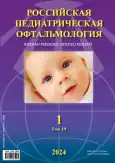Choroidal neovascularization in children: Etiology, diagnosis, and clinical manifestations
- Authors: Katargina L.A.1, Denisova E.V.1, Osipova N.A.1, Kiseleva Y.A.1
-
Affiliations:
- Helmholtz National Medical Research Center of Eye Diseases
- Issue: Vol 19, No 1 (2024)
- Pages: 5-14
- Section: Original study article
- URL: https://journals.rcsi.science/1993-1859/article/view/254278
- DOI: https://doi.org/10.17816/rpoj625525
- ID: 254278
Cite item
Abstract
Few studies have analyzed choroidal neovascularization (CNV) in children because of the low incidence of this complication in pediatric ophthalmology. However, given the significant effect on visual acuity and diagnostic difficulties in children, the study of this complication is relevant.
AIM: This study aimed to analyze the etiological structure and clinical features of CNV in children.
MATERIAL AND METHODS: From 2014 to 2022, 61 eyes of 54 children (26 girls and 28 boys) had CNV. The patients underwent standard ophthalmologic examination and optical coherence tomography (OCT) and OCT angiography (OCTA) of the macular zone and optic disc using the RS-3000 Advance 2 Tomograph (Nidek, Japan).
RESULTS: At the time of CNV diagnosis, the children were 5–17 years old, with a mean of 11±3 years. In 30 children (55.6%), CNV was caused by inflammatory lesions of the retina and choroid. Of these cases, 11 occurred during remission, whereas 21 occurred alongside pathologies of the retina, choroid, and optic nerve of noninflammatory genesis (8 of which were associated with Best’s disease). In three children, CNV was considered idiopathic. The development time of postinflammatory CNV ranged from 1 month to 12 years, with an average of 7.3±5 months from disease onset. Type 2 CNV was found in most cases (48 eyes, 78.7%).
CONCLUSION: CNV is a rare complication of various ocular diseases in children. In our cohort, it was most frequently observed in children with inflammatory lesions of the retina and choroid, even during remission. Patients at risk of CNV must be actively monitored because it occurs in various forms.
Full Text
##article.viewOnOriginalSite##About the authors
Lyudmila A. Katargina
Helmholtz National Medical Research Center of Eye Diseases
Email: katargina@igb.ru
ORCID iD: 0000-0002-4857-0374
MD, Dr. Sci. (Medicine), Professor
Russian Federation, MoscowEkaterina V. Denisova
Helmholtz National Medical Research Center of Eye Diseases
Email: deale_2006@inbox.ru
ORCID iD: 0000-0003-3735-6249
SPIN-code: 4111-4330
MD, Cand. Sci. (Medicine)
Russian Federation, MoscowNatalya A. Osipova
Helmholtz National Medical Research Center of Eye Diseases
Author for correspondence.
Email: natashamma@mail.ru
ORCID iD: 0000-0002-3151-6910
SPIN-code: 5872-6819
MD, Cand. Sci. (Medicine)
Russian Federation, MoscowYana A. Kiseleva
Helmholtz National Medical Research Center of Eye Diseases
Email: drkiseleva@inbox.ru
resident doctor
Russian Federation, MoscowReferences
- Jian L, Panpan Y, Wen X. Current Choroidal Neovascularization Treatment. Ophthalmologica. 2013;230(2):55–61. doi: 10.1159/000351660
- Cohen SY, Laroche A, Leguen Y, et al. Etiology of choroidal neovascularization in young patients. Ophthalmology. 1996;103(8):1241–1244. doi: 10.1016/s0161-6420(96)30515-0
- Moosajee M, Abbouda A, Foot B, et al. Active surveillance of choroidal neovascularisation in children: incidence, aetiology and management findings from a national study in the UK. Br J Ophthalmol. 2018;102(4):438–443. doi: 10.1136/bjophthalmol-2017-310445
- Rishi P, Bharat RPK, Rishi E, et al. Choroidal neovascularization in 111 eyes of children and adolescents. Int Ophthalmol. 2022;42(1):157–166. doi: 10.1007/s10792-021-02018-2
- Mavrikakis E, Levin AV, Lam WC. Choroidal neovascularization secondary to congenital toxoplasmosis in an infant. Can J Ophthalmol. 2010;45(6):e11–e12. doi: 10.3129/i10-087
- Zhang T, Wang Y, Yan W, et al. Choroidal neovascularization in pediatric patients: analysis of etiologic factors, clinical characteristics and treatment outcomes. Front Med (Lausanne). 2021;(8):735805. doi: 10.3389/fmed.2021.735805
- Padhi TR, Anderson BJ, Abbey AM, et al. Choroidal neovascular membrane in paediatric patients: clinical characteristics and outcomes. Br J Ophthalmol. 2018;102(9):1232–1237. doi: 10.1136/bjophthalmol-2017-310497
- Katargina LA, Denisova EV, Arestova NN, et al. OCT-Angiography for the Diagnosis and Monitoring of Best’s Disease. Ophthalmology in Russia. 2019;16(1S):79–85. (In Russ). doi: 10.18008/1816-5095-2019-1S-79-84
- Kayabaşi M, Ataş F, Saatci AO. Unilateral macular neovascularization formation during the follow-up of a 15-year-old boy with Bietti crystalline dystrophy and the successful treatment outcome with a single intravitreal ranibizumab injection. GMS Ophthalmol Cases. 2023;(13):Doc06. doi: 10.3205/oc000214
- Dorsaf S, Khaoula BM, Haifa Z, et al. Choroidal neovascular membrane: Report of pediatric idiopathic case. Junior Medical Research. 2020;3(3):15–19. doi: 10.32512/jmr.3.2.2020/15.19
- Frank KE, Purnell EW. Subretinal neovascularization following rubella retinopathy. Am J Ophthalmol. 1978;86(4):462–466. doi: 10.1016/0002-9394(78)90290-8
- Hirano K, Tanikawa A, Miyake Y. Neovascular maculopathy associated with rubella retinopathy. Jpn J Ophthalmol. 2000;44(6):697. doi: 10.1016/s0021-5155(00)00266-5
- Goshorn EB, Hoover DL, Eller AW, et al. Subretinal neovascularization in children and adolescents. J Pediatr Ophthalmol Strabismus. 1995;32(3):178–182. doi: 10.3928/0191-3913-19950501-11
- Daniels AB, Jakobiec FA, Westerfeld CB, et al. Idiopathic subfoveal choroidal neovascular membrane in a 21-month-old child: ultrastructural features and implication for membranogenesis. J AAPOS. 2010;14(3):244–250. doi: 10.1016/j.jaapos.2010.01.010
- Abri A, Binder S, Pavelka M, et al. Choroidal neovascularization in a child with traumatic choroidal rupture: clinical and ultrastructural findings. Clin Exp Ophthalmol. 2006;34(5):460–463. doi: 10.1111/j.1442-9071.2006.01248.x
- Lee EJ, Mavrikakis I, Fong K, Casswell AG. Primary peripapillary membrane in an 8-year-old boy. Eye (Lond). 2006;20(3):379–380. doi: 10.1038/sj.eye.6701847
- Barth T, Zeman F, Helbig H, Oberacher-Velten I. Etiology and treatment of choroidal neovascularization in pediatric patients. Eur J Ophthalmol. 2016;26(5):388–393. doi: 10.5301/ejo.5000820
- Agarwal A, Invernizzi A, Singh RB, et al. An update on inflammatory choroidal neovascularization: epidemiology, multimodal imaging, and management. J Ophthalmic Inflamm Infect. 2018;8(1):13. doi: 10.1186/s12348-018-0155-6
- Baxter SL, Pistilli M, Pujari SS, et al. Risk of choroidal neovascularization among the uveitides. Am J Ophthalmol. 2013;156(3):468.e2–477.e2. doi: 10.1016/j.ajo.2013.04.040
- Rhee DY, Reichel E, Rogers A, Strominger M. Subfoveal choroidal neovascularization in a 3-year-old child with North Carolina macular dystrophy. J AAPOS. 2007;11(6):614–615. doi: 10.1016/j.jaapos.2007.06.010
- Denisova EV, Nikishina IP, Khrabrova MA. Novel algorithm for screening, treating, and monitoring uveitis in children with juvenile idiopathic arthritis. Russian Pediatric Ophthalmology. 2020;15(1):36–44. (In Russ). doi: 10.17816/rpo2020-15-1-36-44
Supplementary files
















